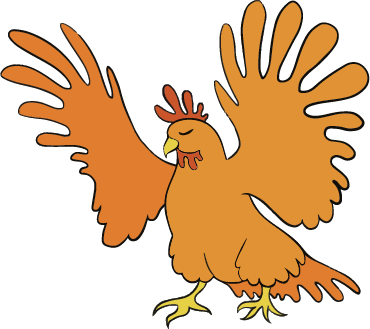Exquisite Corpse
Motion graphics sequence mirroring the protest movement of the 1960s and ‘70s for the rights of human beings with those of non-human animals in the present day. The overarching theme: the only difference is your perception.
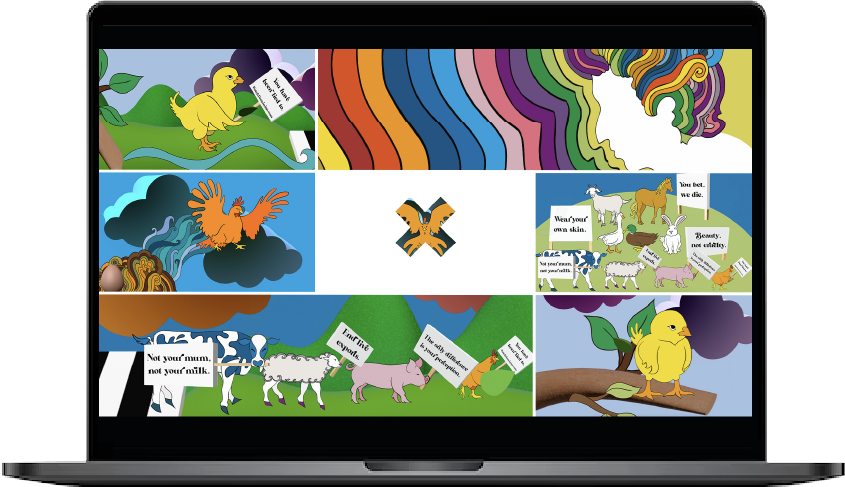
“Exquisite Corpse” is a captivating and thought-provoking motion graphic project designed to convey a powerful message about advocacy for farmed animals. The narrative unfolds through a series of interconnected scenes, blending whimsical 2D and 3D animation with symbolism to depict the transformative journey of a chicken championing animal rights.
The Brief
In addressing the overlooked sentience of farmed animals, this project prompts you to explore the quote, “Everything in the world has a spirit which is released by its sound.” Collaborate with peers using an exquisite corpse method, crafting a motion response that starts and ends on a shape of your choice. Integrate 3D motion graphics, highlighting the interconnected spirit of living beings, particularly the often-neglected farmed animals. Elevate your visuals with thoughtful sound design, considering collaboration with a sound designer for a polished outcome. This creative journey serves not only to unpack a quote but also advocates for positive change, fostering empathy and awareness for the voiceless.
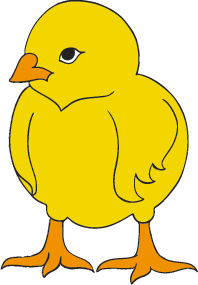
Tools
Procreate, Adobe After Effects, Cinema 4D, Adobe Audition
Role
Motion designer, graphic designer
Duration
October to November 2022
(2 months)
Design Process

Pre-production
Research | Brainstorm | Sketches | Moodboards | Synopsis | Word list | Storyboards | Style frames

Production
Asset creation
Animation
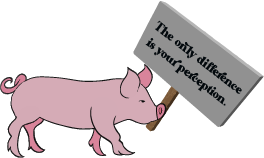
Post-production
Editing
Sound design

The Recipe
Motion graphics sequence
Motion frames

Pre-production
Research
Exquisite Corpse
I conducted research on the origins of an exquisite corpse, discovering its French term, “cadavre exquis,” and its association with the surrealist movement in the 1920s. This initial inspiration prompted me to adopt a surrealist approach in developing the motion response. I also explored different potential art directions, briefly contemplating the influence of Art Nouveau. Prior to learning about the X marking the cut between each student’s work, I also contemplated the three possible narrative methods: continuation from the previous frame, a distinct cut, or a set theme.
Oskar Fischinger
The brief quote interested me, prompting research on the creator. I found Oskar Fischinger was crucial to the abstract sequences in ‘Fantasia’. The film primarily consists of abstract elements and interconnected smaller stories. Drawing from my previous understanding, I recalled that these abstractions are commonly referred to as the “Disney acid sequence”, which served as a source of inspiration for me. With the prevalence of scenes featuring pegasi, I aimed to respectfully incorporate this element in my response.
Disney Acid Sequence
While exploring the various surreal elements found in Disney films, particularly the fascinating “Pink Elephants” scene in Dumbo, it reminded me of my initial interest in surrealism. This curiosity gradually led me to delve into the concept of psychedelia, prompting me to investigate the design trends prevalent in the 1960s and ’70s.
1960s graphic design
Among the well-known design trends from the 1960s, psychedelia, pop art, and op art are particularly notable. Psychedelia was influenced by Art Nouveau and its organic, hand-drawn aesthetic. Milton Glaser’s posters, including the famous one featuring Bob Dylan, were particularly influential during this period. This served as an inspiration for me to incorporate the narrative of protest songs and folk singers from that era into my work.
Brainstorm
“Everything in the world has a spirit which is released by its sound.”
I considered this quote first in the context of spirit animals and the many cultures that hold this belief, such as Tibetans, Native Americans, and Indigenous Australians. This inspired me to consider the animals that humans forget, namely farmed animals. The notion of spirit I likened to sentience, which all living beings have. Sound can be thought of in two forms: their voicelessness and inability to speak for themselves, and the power of communication and advocacy on the part of those that can speak up (we as humans).

Sketches
These were the initial sketches from the concept. It clearly evolved to a level that was not all that achievable in 20 seconds! I had tried to encompass a lot, when a single narrative would have been more applicable. The sketches on the following page are from the revision of my work considerably after creating an animatic and discovering just how little could actually be shown in the time allotted.

Sketches to refined idea
This is the result of my having to constrain the ideas that would otherwise take a minute on-screen, and follow a primary concept. From the previous drawings, it follows the chick as they develop into a chicken and cross the road followed by other farmed animals, but brings also a protest motif earlier on in the piece.
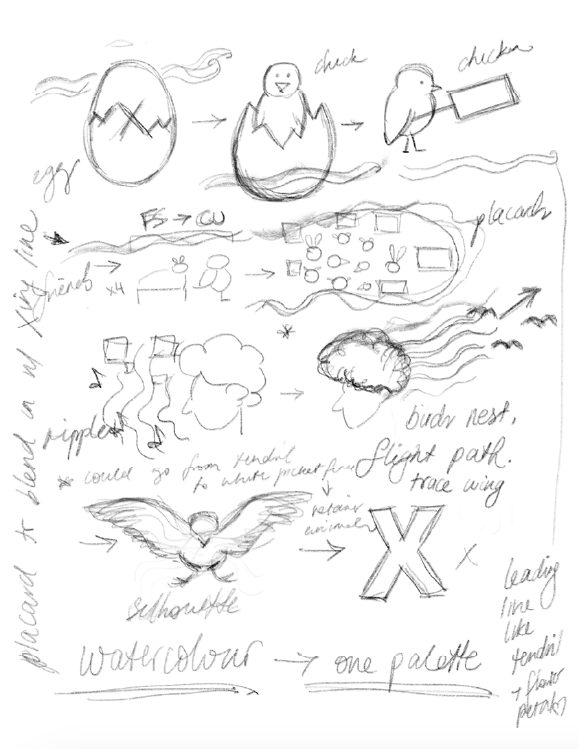

Moodboard
The visual direction changed considerably during pre-production, as the original concept was to have an art style that shifts throughout. For instance, the 1960s homage would become a Disney style of illustration and then to simple line art. While this may have worked for a longer video, I instead focussed on one primary design direction. These were the moodboards that corresponded with the original narrative in its entirety.
Yellow Submarine

1960s psychedelia

Disney Acid Sequence
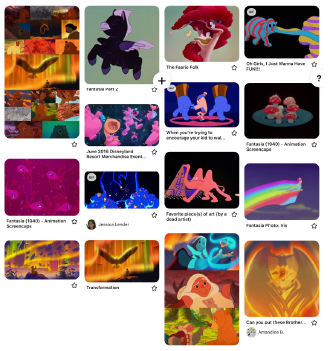
Op Art

Pop Art / Photomontage

3D / Environments

Synopsis
The X which marks the start and end scene of each video masks a chick hatching from an egg. The chick reaches for a placard while walking from their branch in a tree. They walk across a road, whilst growing up into a fully grown chicken. They are followed by three other farmed animals, each holding protest signs. There is a brief shot which is an homage to Abbey Road. A leading line and leaf, as well as background clouds, tie each scene together.
The animals continue to walk into an area with other farmed animals who are also protesting, they all become fenced in. The next shot is Bob Dylan in the style of Milton Glaser, who is singing protest songs, communicating the power of one’s voice and the importance of advocacy.
Dylan moves to the bottom left of the frame as his hair becomes a bird’s nest. A trail like the leading line from before flows from his hair, and is followed by the flying chicken. The chicken then flies into the next shot (in the centre of the frame) and match cuts with the X.
Word list
- Protest
- Kindness
- Sentience
- Moral baseline
- 1960s
- Psychedelic
- Advocacy
- Voiceless
- Power
- Reconsider
- Dream
- Potential
Storyboards
The storyboarding went through three iterations, as I did not comprehend the scope that could be communicated in only 20 seconds.

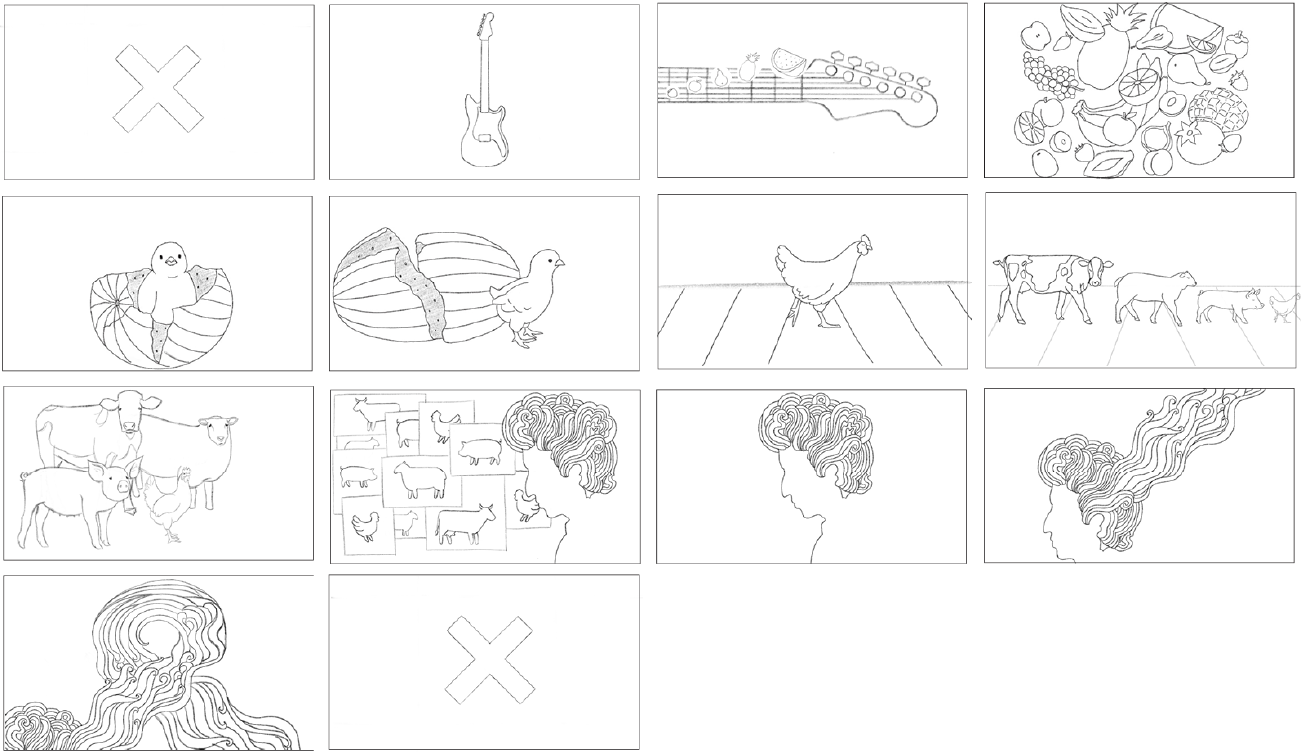

Styleframes
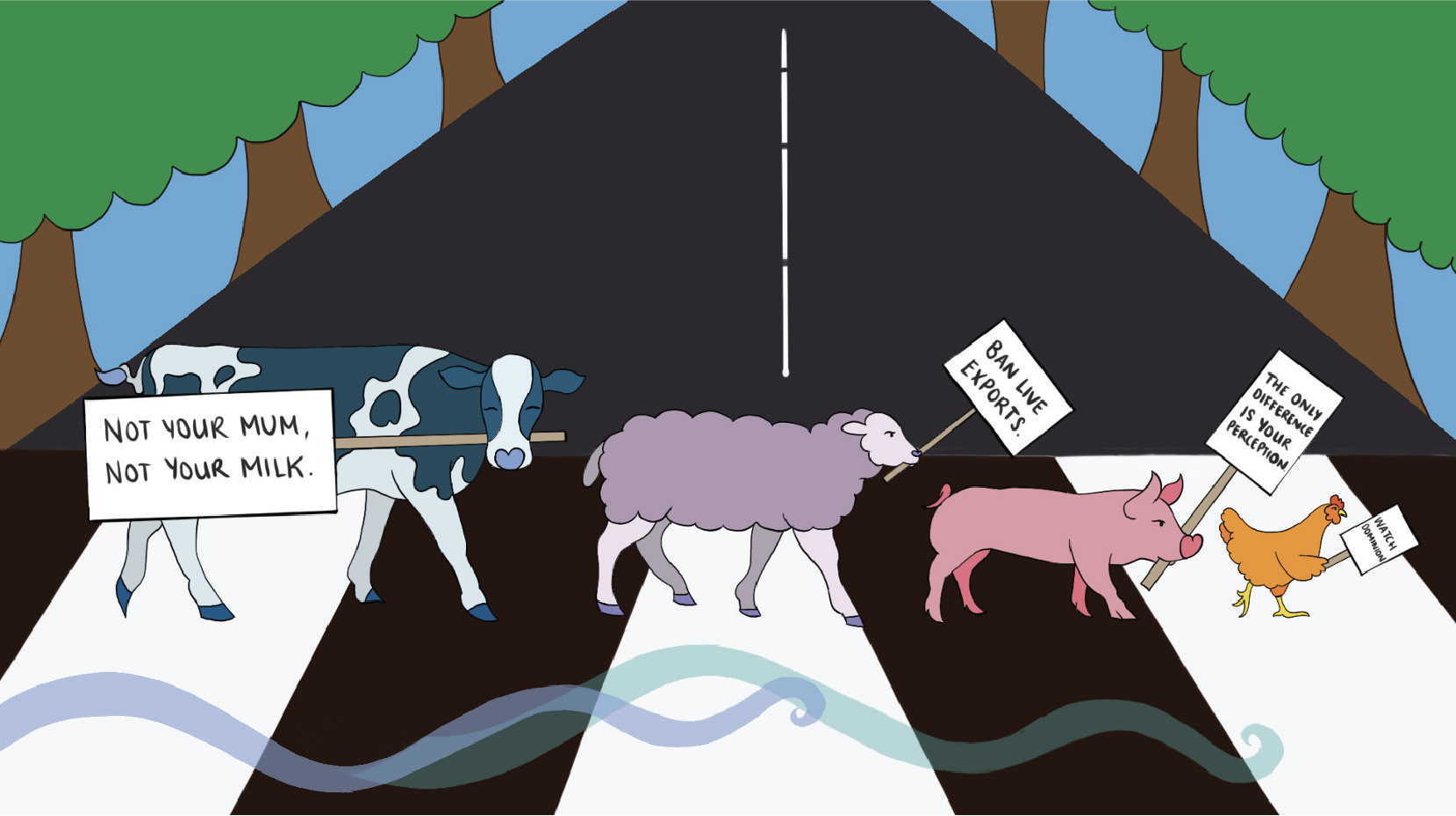
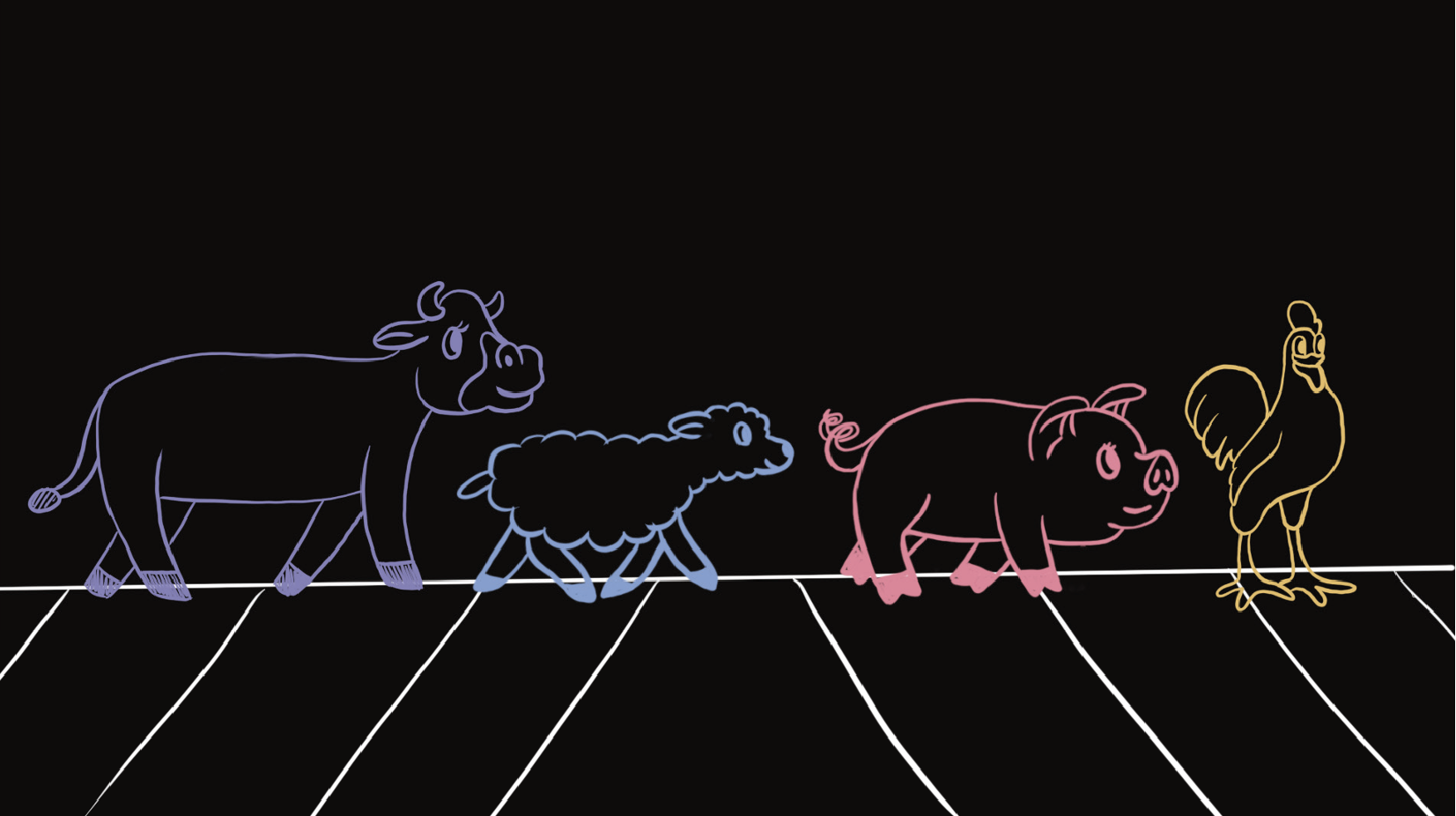
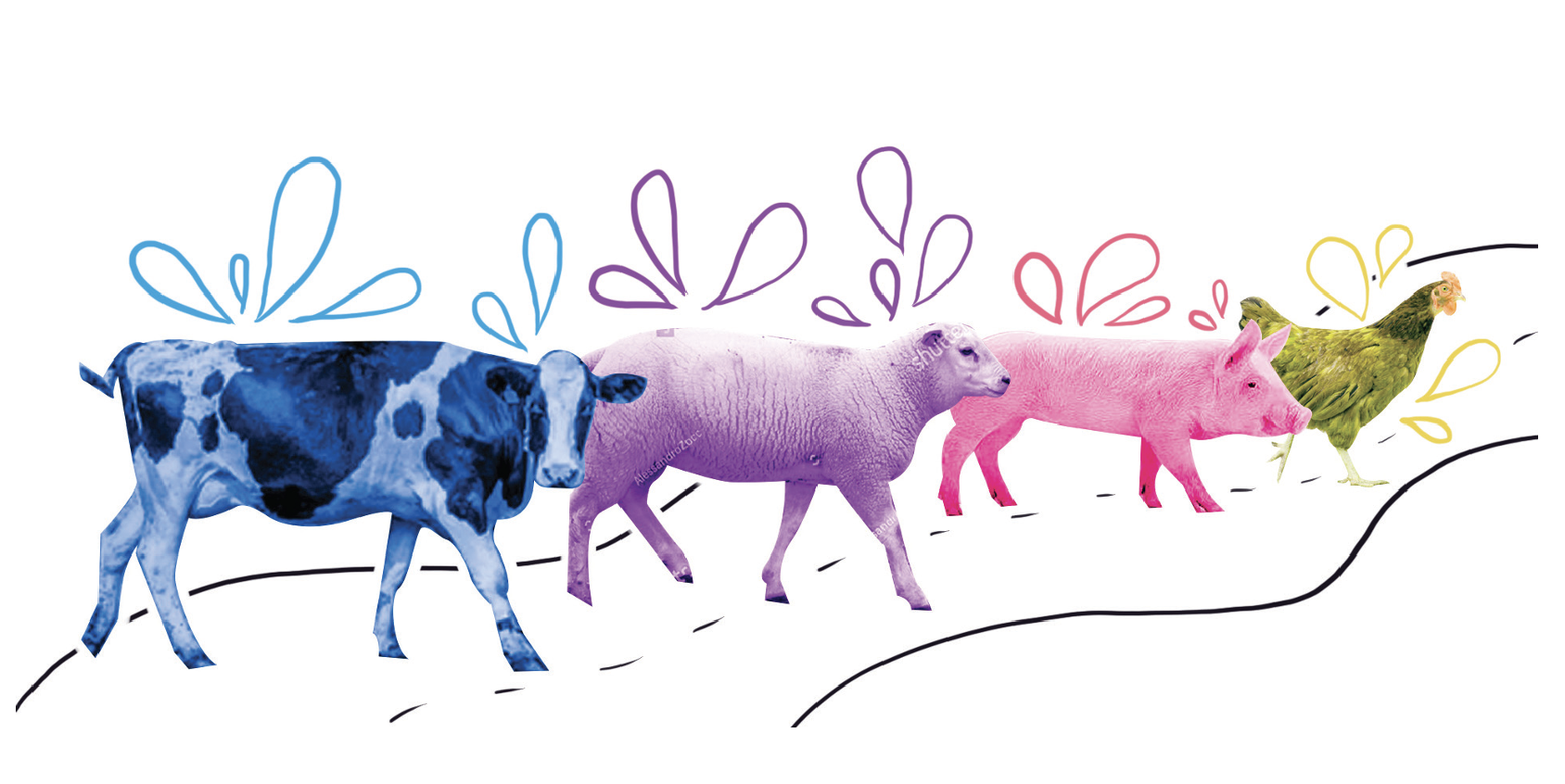

Production
Asset creation
2D assets
After storyboarding and deciding on a design direction, I began illustrating on Procreate (pictured below). I designated which assets were to be 2D – primarily the characters – and those to be 3D – the background elements.

After illustrating, each layer required importing into Adobe Illustrator. I applied an Image Trace (16 Colours), and cleaned up some areas that didn’t trace properly. To the right is an overview of my process for each asset that appears.

3D assets
I was cognisant of my own limitations with Cinema 4D, as well as the time constraints. I thus wanted to reduce the amount of 3D animation required. Many assets that I initially created went through a second round of development as I was not satisfied with how they looked in the scenes when imported into After Effects.

Animation was mainly in the form of Deformers and Generators, as well as moving along spline paths for camera tracking. Depicted are both non- and animated 3D assets.

Animation
After Effects
I imported all files from Illustrator as compositions with layers, and Cinema 4D as PNGs or PNG sequences. I had also set up animated files in C4D to include a green or blue screen behind, so that I could apply a keylight to the material, providing a transparent background to the object.
I created compositions for each grouped object. These included all the farmed animals, as their limbs required movement; branches; trees on the left and right of the road; Bob Dylan, as well as the vibrations and musical notation; the chicken flying from the nest; and the final scene that matches the X.
As it was only a 20 second sequence, I added more objects onto the timeline than I regularly would, rather than precomping them all. (I don’t think my RAM liked this very much.) I have provided an overview screenshot of the setup (with all sequences unpacked, of course!)

The 3D animations required time remapping, as I had exported them in very short durations (1-2 seconds) so they would render reasonably fast. Masks were applied to the trails. I also used a mask on the top and bottom of the 3D fence to follow the trail. The start and end shots utilise an inverted mask on a white solid.
To get the feeling of flow and continuity, I applied position keyframes so that each scene would slide into frame following the previous. I did also want the movement to have a slightly chaotic feeling complementing the video’s brevity. As such, there is a slight overlap between scenes as they transition.


Post-production
Animation and post-production
After Effects
I continued to build each scene, ensuring that there wasn’t too much going on in each shot so that the viewer could still focus on the main subject. In this regard I actually ended up removing some background objects and limiting the 3D clouds to two per scene.
I played around with the scale of objects, and decided to go big or go home and fill most of the frame, as this should encourage repeat watching. While I did have a storyboard to reference, a lot of this project was trial and error, making adjustments where necessary. If this document were to follow a chronological flow there would be quite a bit of jumping about!
While I utilised and referenced my original colour palette from Procreate for all 2D assets and solids, I experimented with colour correction in After Effects for the 3D assets. This really helped bring otherwise plain hills, trees, and clouds to life by injecting them with an almost dayglow essence. For this effect, I used Colorista V from the Magic Bullet suite and occassionally Lumetri Color where such a bold gradient wasn’t necessary (such as the 3D fence). Brightness and Contrast was applied to the signs to make the text pop, as their initial designs in Cinema 4D were just a default white.
As the final shot with the X was smaller than I had storyboarded, I used a mask expansion from 100 to 0% and shrinking scale following the flying chicken composition. I included the clouds within the comp so that there would be momentary movement before it freezes for the following student’s sequence.


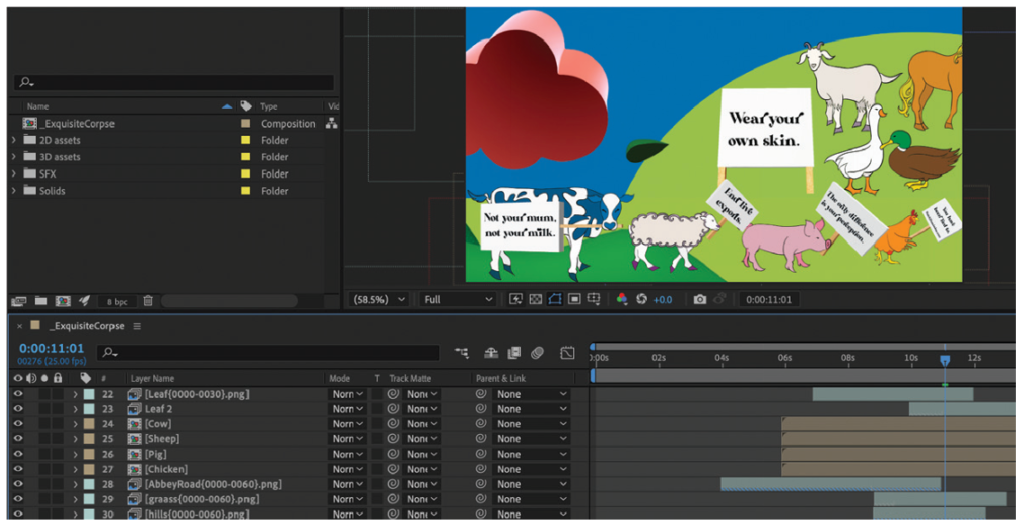
Sound design
I sought a sound designer during production and gave them a clear direction for the soundtrack – a 1960s folk-inspired piece reminiscent of Bob Dylan’s ‘Subterranean Homesick Blues’ and and Buffalo Springfield’s ‘For What It’s Worth’. I showed them the animatic, synopsis, and styleframe.
They encountered a computer issue, so I decided to use tracks from Epidemic Sound instead. I found one that reminded me of ‘House of the Rising Sun’ and it worked well with the animation. I had to edit it in Audition to fit the 20-second requirement and fade out at the end. The track is called Dust Bowl.

The Recipe (Outcome)
Motion frames
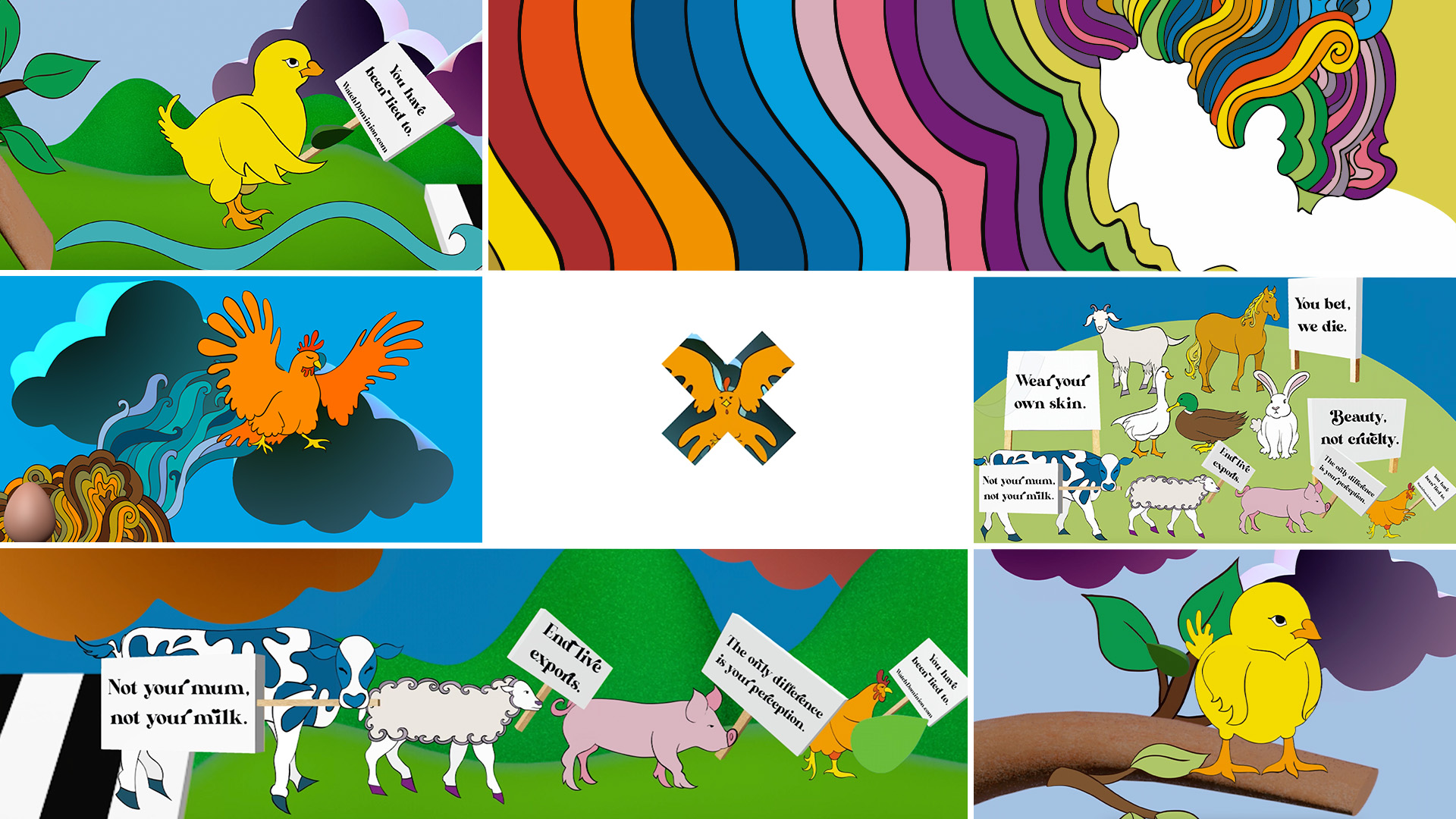
Motion graphics sequence
Reflection
“Exquisite Corpse” was an engaging exploration of motion graphics, drawing inspiration from the protest movements of the 1960s and promoting the rights of both humans and non-human animals. Sparked by the concept that everything has spirit (and sentience) released through sound, thorough research and careful storyboarding culminated in a concise yet important 20-second narrative. The combination of 2D and 3D animation, alongside a fortunate soundtrack discovery, resulted in a thought-provoking motion graphic that resonates with the concepts of interconnectivity and the influence of advocacy. I would someday like to lengthen this motion graphics response to include the themes present in Animals Australia’s campaigns, such as “When pigs fly”, to tie the narratives together.
